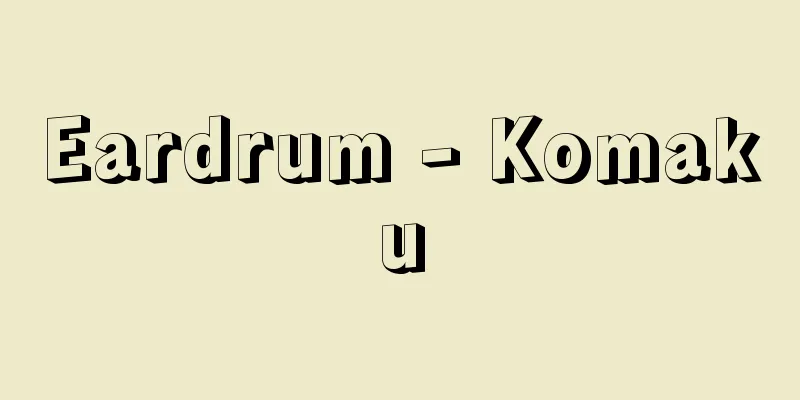Eardrum - Komaku

|
It is a nearly circular membrane located at the very back of the ear canal, measuring approximately 9 mm in major axis, 8.5 mm in minor axis, and 0.1 mm thick. It is cone-shaped with a slight depression in the middle, and stretches diagonally from top to bottom in the ear canal. Inside the eardrum is the air-filled tympanic cavity (middle ear cavity), and the malleus, the outermost bone of the ossicular chain, is attached to the back of the eardrum. Sound waves entering the ear canal are effectively received by the cone-shaped eardrum, causing it to vibrate. These vibrations are transmitted to the malleus and then through the ossicular chain to the inner ear, where they excite the cochlear nerve, and ultimately stimulate the auditory cortex of the cerebrum, allowing us to perceive it as sound. Because the eardrum is very thin, it can easily be ruptured by a blow to the ear, a blast, or changes in air pressure caused by diving, or by pus accumulating in the eardrum due to otitis media, which is called a perforated eardrum. If the perforation is fresh, it is relatively easy to heal, but if it remains, it can cause hearing loss and can cause contamination from the external auditory canal, making it easier to develop otitis media. [Masami Kawamura] Animal eardrumA part of the sound receptors found in amphibians and higher vertebrates and insects. In vertebrates, it is a thin, elastic membrane that stretches over the entrance to the middle ear, and vibrates when it receives sound waves. In amphibians, reptiles, and birds, the vibrations are transmitted to the eustachian tubercle, which originates from the tongue and jaw cartilage of fish. The vibrations of the eustachian tubercle are transmitted to the membranous labyrinth of the inner ear, exciting the sensory cells inside the labyrinth. In mammals, the vibrations of the eardrum are transmitted in the following order: malleus, which originates from the articular bone of reptiles; incus, which originates from the stapes; and finally the stapes, which is a reduced and deformed eustachian tubercle. The sound receptors of insects are called the tympanic organ, and the thin layer of the epidermis of the tracheal ampulla is called the tympanic membrane. The sensory cells of the tympanic organ are in contact with the tympanic membrane. The location of the tympanic organ varies depending on the species; for example, in grasshoppers and crickets, it is located at the base of the forelimb tibia, and in grasshoppers, it is located on both sides of the first abdominal segment. [Seiichiro Kawashima] [References] | | |©Shogakukan "> Ear structure Source: Shogakukan Encyclopedia Nipponica About Encyclopedia Nipponica Information | Legend |
|
外耳道のもっとも奥にあるほぼ円形の膜で、大きさは長径が約9ミリメートル、短径が約8.5ミリメートル、厚さは0.1ミリメートルの薄い膜である。中央がややへこんだコーン状で、外耳道に上方から下方へ斜めに張っている。鼓膜の内側は空気の入った鼓室(中耳腔(くう))で、耳小骨連鎖のもっとも外側の骨であるツチ骨が鼓膜の裏側についている。外耳道から入ってきた音波はコーン状の鼓膜で効果的に受け取られ、鼓膜が振動する。この振動がツチ骨、さらに耳小骨連鎖を経て内耳に伝わり、そこで蝸牛(かぎゅう)神経を興奮させ、最終的に大脳の聴野を刺激して音として感じ取ることができる。 鼓膜は非常に薄いので、耳の平手打ち、爆風、あるいは潜水などによる気圧変化、中耳炎で鼓室に膿(のう)が貯留するなどの原因で簡単に破れることがあり、これを鼓膜穿孔(せんこう)という。穿孔が新鮮な場合は比較的治癒しやすいが、穿孔が残ると難聴となるし、外耳道から汚染して中耳炎をおこしやすくなる。 [河村正三] 動物の鼓膜両生類以上の脊椎(せきつい)動物と昆虫にある音受容器の一部。脊椎動物では中耳の入口に張っている弾力に富んだ薄い膜で、音波を受けて振動する。振動は、両生類、爬虫(はちゅう)類、鳥類では、魚類の舌顎(ぜつがく)軟骨に由来する耳小柱(じしょうちゅう)に伝えられる。耳小柱の振動は、内耳の膜迷路に伝わり、膜迷路の内部にある感覚細胞を興奮させる。哺乳(ほにゅう)類では、鼓膜の振動は、爬虫類の関節骨由来のツチ骨(槌骨)、方骨由来のキヌタ骨(砧骨)、耳小柱が縮小変形したアブミ骨(鐙骨)の順に伝えられる。 昆虫の音受容器は鼓膜器官といい、気管膨大部の表皮が薄膜状になったものを鼓膜とよぶ。鼓膜に接して鼓膜器官の感覚細胞がある。鼓膜器官は、キリギリスやコオロギでは前肢の脛節(けいせつ)の付け根、バッタでは第1腹節の両側にあるなど、位置は種により異なる。 [川島誠一郎] [参照項目] | | |©Shogakukan"> 耳の構造 出典 小学館 日本大百科全書(ニッポニカ)日本大百科全書(ニッポニカ)について 情報 | 凡例 |
<<: Dicentra peregrina; dicentra
Recommend
Drapery
…In Japan, it is called drapery in English and dr...
Saytzeff rule
In some fields, the English pronunciation of Seyts...
Accountability
… [Accounting Functions] The functions of account...
Kagamiga Naru - Kagamiga Naru
This plateau is located in Kofu Town, Hino County,...
awqāf (English spelling) awqaf
…Arabic word meaning "stop" (plural awq...
Clerodendrum foetidum (English spelling) Clerodendrum foetidum
…[Kazuo Furusato]. … *Some of the terminology tha...
snout
…When the proboscis sheath that encloses the snou...
Carex lanceolata (English spelling)
…[Tetsuo Koyama]. … *Some of the terminology that...
Semi-precious stone (English spelling)
...Therefore, even if artificial crystals, or syn...
series integral (English spelling)
...A compositional technique that was widely used...
Giuseppe Pitrè
1841‐1916 Italian folklorist. Born in Palermo, Sic...
Thorndike - Edward Lee Thorndike
American psychologist. Born in Massachusetts. He ...
Masakado - Masakado
Kabuki dance piece. Tokiwazu. Original title: &quo...
Housework subjects - Kajikamoku
...One tradition of home economics, which focuses...
Ladislaus von Bortkiewicz
1868‐1931 Statistician and economist. Polish, born...

![Suzu [city] - Suzu](/upload/images/67cbf4ab04f4a.webp)




![American Waltham Clock [Company] - American Waltham Clock](/upload/images/67cf3ee5cf448.webp)


